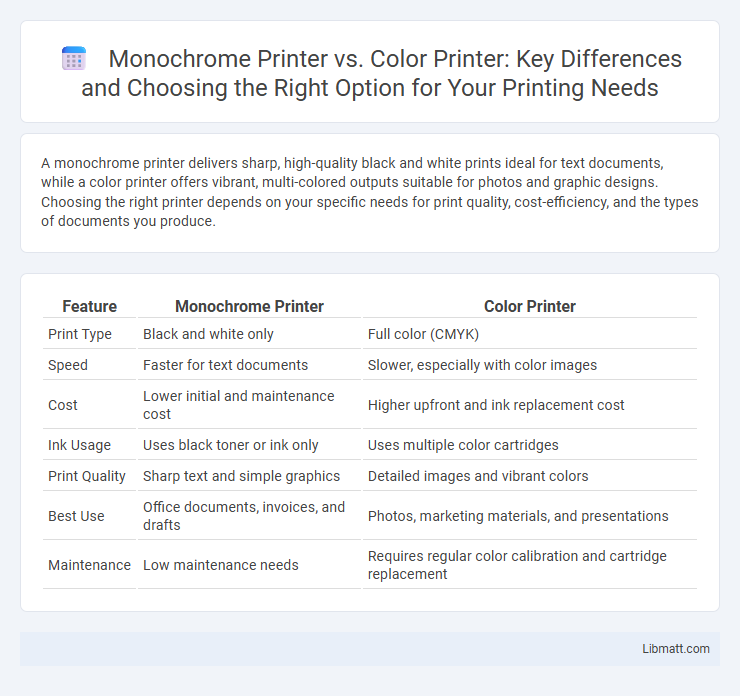A monochrome printer delivers sharp, high-quality black and white prints ideal for text documents, while a color printer offers vibrant, multi-colored outputs suitable for photos and graphic designs. Choosing the right printer depends on your specific needs for print quality, cost-efficiency, and the types of documents you produce.
Table of Comparison
| Feature | Monochrome Printer | Color Printer |
|---|---|---|
| Print Type | Black and white only | Full color (CMYK) |
| Speed | Faster for text documents | Slower, especially with color images |
| Cost | Lower initial and maintenance cost | Higher upfront and ink replacement cost |
| Ink Usage | Uses black toner or ink only | Uses multiple color cartridges |
| Print Quality | Sharp text and simple graphics | Detailed images and vibrant colors |
| Best Use | Office documents, invoices, and drafts | Photos, marketing materials, and presentations |
| Maintenance | Low maintenance needs | Requires regular color calibration and cartridge replacement |
Introduction to Monochrome vs Color Printers
Monochrome printers specialize in printing black-and-white documents, offering faster output and lower operational costs compared to color printers, which utilize multiple ink cartridges to produce a wide spectrum of colors ideal for vibrant images and graphics. Businesses requiring high-volume text printing often prefer monochrome printers for their efficiency and sharp text quality. Color printers cater to environments where detailed graphics, photos, and marketing materials are essential, despite higher ink expenses and slower print speeds.
Key Differences Between Monochrome and Color Printers
Monochrome printers exclusively use black ink or toner, producing sharp text documents with higher speed and lower operational costs, making them ideal for office environments focused on text-heavy printing. Color printers utilize multiple ink cartridges or toners to create a full spectrum of colors, enabling vibrant photo printing and detailed graphics but often at a higher price per page and slower print speeds. Your choice depends on whether you prioritize cost-efficient, high-volume black-and-white printing or need versatile color output for diverse print projects.
Print Quality: Monochrome vs Color
Monochrome printers deliver sharp, high-contrast black-and-white prints ideal for text-heavy documents, ensuring clear readability and professional appearance at lower costs. Color printers produce vibrant, detailed images with a wide color gamut suited for graphics, photos, and marketing materials where visual impact is crucial. Your choice depends on whether print quality demands precise monochrome text or rich, full-color output.
Cost Comparison: Purchase and Maintenance
Monochrome printers typically have a lower initial purchase price compared to color printers, making them more cost-effective for users primarily printing black-and-white documents. Maintenance costs for monochrome printers are also generally lower since they require only black toner or ink, reducing the frequency and expense of cartridge replacements. In contrast, color printers involve higher upfront investment and increased maintenance expenses due to multiple ink cartridges or toners, which can significantly impact long-term operational costs.
Speed and Efficiency: Which Printer Performs Better?
Monochrome printers generally offer faster printing speeds by focusing solely on black and white output, making them more efficient for high-volume document printing tasks. Color printers typically print slower due to the additional process of blending multiple ink cartridges for accurate color reproduction. Your decision should consider whether speed and efficiency for text documents outweigh the need for vibrant color output.
Ideal Use Cases for Monochrome Printers
Monochrome printers excel in environments requiring high-volume black-and-white document printing, such as offices producing contracts, invoices, and reports. Their faster print speeds and lower operating costs make them ideal for businesses prioritizing efficiency over color output. Your choice of a monochrome printer is optimal when clarity and affordability in monochrome text are crucial.
Ideal Use Cases for Color Printers
Color printers are ideal for producing vivid marketing materials, high-quality photographs, and detailed graphics that require accurate color representation. They are essential in environments such as design studios, advertising agencies, and educational institutions where presentations and visual content demand vibrant, multi-colored output. Businesses focusing on branded materials, client proposals, and promotional products benefit significantly from the diverse color capabilities of these printers.
Energy Consumption and Environmental Impact
Monochrome printers consume significantly less energy compared to color printers due to their simpler printing technology and limited ink usage, resulting in lower electricity costs over time. The environmental impact of monochrome printers is reduced as they use fewer consumables like color cartridges, minimizing plastic waste and chemical disposal. Color printers, while offering versatility, typically have a higher carbon footprint because of increased energy demands and the frequent replacement of multiple color cartridges.
Factors to Consider When Choosing a Printer
When choosing a printer, consider print volume, color requirements, and budget to determine whether a monochrome printer or color printer suits your needs. Monochrome printers excel in high-speed, cost-effective black-and-white document printing, making them ideal for offices with heavy text-based output. Your decision should also weigh factors such as maintenance costs, print quality, and the necessity for vibrant images or graphics in your documents.
Conclusion: Monochrome or Color – Which Suits Your Needs?
Monochrome printers offer cost-effective, fast printing ideal for text-heavy documents, while color printers provide vibrant, detailed output perfect for images and marketing materials. Your choice depends on whether your primary need is efficiency and clarity or visual impact and versatility. Assess printing volume, budget, and color requirements to determine which type best suits your specific needs.
Monochrome Printer vs Color Printer Infographic

 libmatt.com
libmatt.com